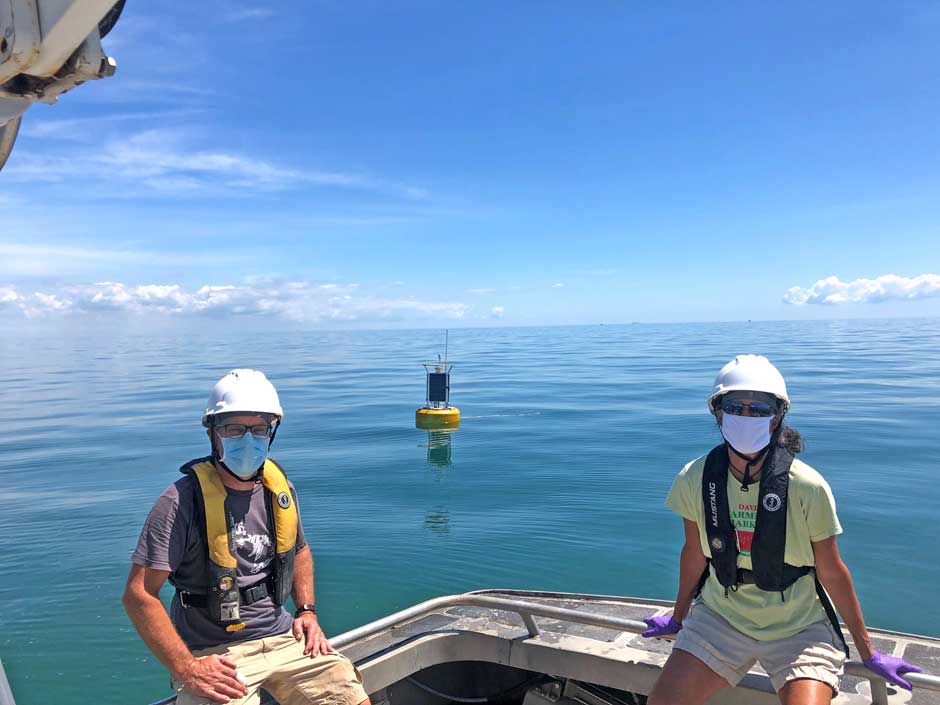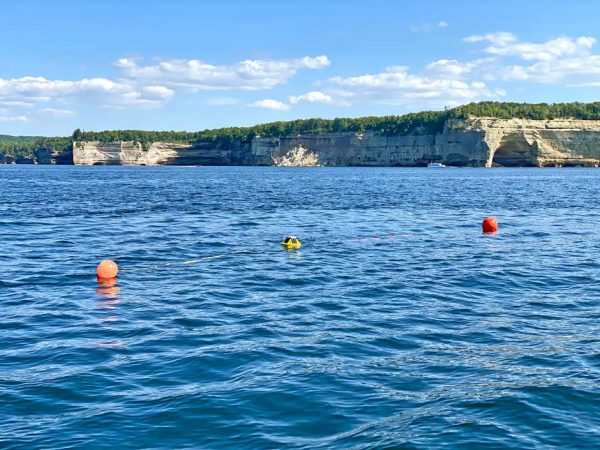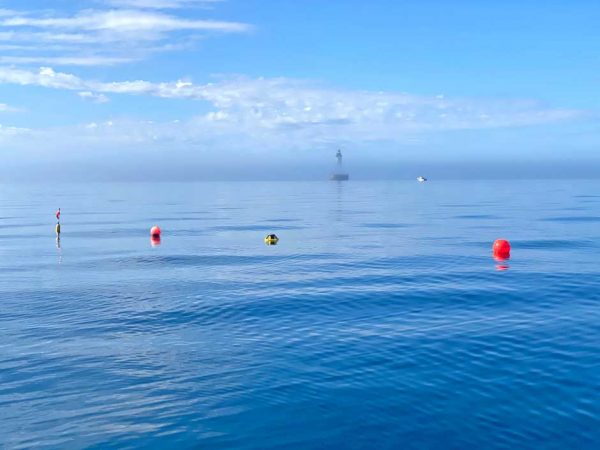Buoys in the time of Covid: Delays to important information
 Cooperative Institute for Great Lakes Research (CIGLR) researchers Russ Miller and Heidi Purcell deploy a NOAA GLERL Realtime Coastal Observation Network (ReCON) buoy in western Lake Erie on July 14, 2020. NOAA GLERL's ReCON buoys continuously collect meteorological data and provide sub-surface measurements of chemical, biological, and physical parameters. To view this data and learn more about the ReCON project, visit www.glerl.noaa.gov/metdata/metReCON.html. (Credit: NOAA GLERL)
Cooperative Institute for Great Lakes Research (CIGLR) researchers Russ Miller and Heidi Purcell deploy a NOAA GLERL Realtime Coastal Observation Network (ReCON) buoy in western Lake Erie on July 14, 2020. NOAA GLERL's ReCON buoys continuously collect meteorological data and provide sub-surface measurements of chemical, biological, and physical parameters. To view this data and learn more about the ReCON project, visit www.glerl.noaa.gov/metdata/metReCON.html. (Credit: NOAA GLERL)In early 2020, Michigan found itself facing one of the worst outbreaks of Covid-19 in the country. Though it’s close to second nature now, businesses, schools and governments were suddenly forced to conduct business without close contact. Universities and research institutions had to pause some scientific research. Whatever was able to continue slowed to a crawl.
Around the Great Lakes, a network of buoys monitors dozens of water quality parameters and lake conditions, reporting them in real time. This year, the monitoring season was cut a bit short as Covid-19 restrictions hit in the weeks before buoys were set to be deployed.
“We ended up being, depending on the buoy, 8-10 weeks later,” said Steve Ruberg, a researcher at the National Oceanic and Atmospheric Administration’s Great Lakes Environmental Research Laboratory (GLERL).
During the spring, summer and fall, GLERL deploys buoys on Lakes Michigan, Huron and Erie. The data they report back is used by cargo ships, fishermen and the National Weather Service, which uses them to validate their weather predicting models.
“[NOAA’s National Weather Service] consider these systems we deploy to be essential for the physical characteristics of water: wind speed, wind direction, air temperature, water temperature and wave observations,” Ruberg said.
Municipal water intake managers use data from buoys, especially in Lake Erie, to track nutrients and algal bloom development, which has disrupted water supplies in the past.
That important information was inaccessible and uncollected during the delay.
A team effort, interrupted
Like everyone else at that time, the team responsible for getting buoys ready for the season and into the lakes had to establish all new procedures based on the state’s guidelines.
Before Covid, this process was one that was “free flowing” and full of interactions between team members, Ruberg said. This past season, interaction was potentially dangerous and the additional precautions slowed the process down. Share on XIn a typical year, buoy preparation and deployment are deadline driven at GLERL, Ruberg said.
“This year we’re safety driven,” he said. “Covid guidelines and measures driven.”

One of the Great Lakes Research Center’s spotter buoy near Pictured Rocks National Lakeshore. (Courtesy: John Lenters)
In fall, buoys come out of the lakes before they can be damaged by lake ice. Removing the buoys was easier than putting them in. By that time, the lab was comfortable with Covid procedures and precautions after months of operating with them.
Still, Ruberg said, GLERL was a bit proactive in getting them out. The removal process can be disrupted by inclement weather, so this year, Ruberg said, the lab was sure to take advantage of fair weather and avoid weather-related complications that could extend operations and increase risk of Covid-19 exposure. The buoys may have come out a bit earlier than in a typical year.
Expanding a buoy fleet in the face of restrictions
Elsewhere in the Great Lakes basin, the disruption of Covid-19 led to a larger buoy fleet at Michigan Technological University (MTU), in the state’s Upper Peninsula.
When it became clear that Covid-19 would delay buoy deployment in the region, the team at the university’s Great Lakes Research Center were looking for a way to fill the gap.
“If there’s going to be a lot of buoys missing due to Covid, we want to get as many more out there as we can,” said John Lenters, a research scientist at the center. Lenters and his colleagues turned to small, easily-deployable buoys.
Early in 2020, the Great Lakes Research Center had purchased a Spotter buoy, produced by Sofar Ocean, which is easy to deploy. Their small size and simple design meant only a small team was needed to deploy them. (Two or three people socially distanced in a boat, Lenters said.)
Seeing the need for more, similar buoys, the Great Lakes Research Center purchased a second Spotter buoy with a rapid grant from the Cooperative Institute for Great Lakes Research, which is funded by NOAA’s GLERL and run out of University of Michigan. Additional funds from MTU purchased a third.

One of the Great Lakes Research Center’s spotter buoy near Stannard Rock Lighthouse with a fishing boat in the background. (Courtesy: John Lenters)
These buoys provide information on wave height and period, as well as other physical characteristics on the lake, and provide data that keeps boaters safe.
Covid-19 restrictions still meant buoys arrived on the lake later than a typical year, but only about three weeks, Lenters said.
The first of the Spotter buoys was deployed in April in support of a dredging project, which was removing contaminated sediment and protecting fish spawning grounds in Lake Superior. It was the first buoy on Lake Superior in 2020, as far as Lenters knows.
Another of the Spotters was deployed near Pictured Rocks National Lakeshore. The buoy was the most frequently accessed data for Lake Superior in the Great Lakes Observing System in 2020, Lenters said. The area is popular with kayakers, who rely on real-time lake conditions for safety.
The third buoy was set at Stannard Rock, in an area popular with fishermen, to whom lake condition information is crucial to keeping safe. It’s a goal each of these buoys helped achieve.
“It was a public safety issue, really,” Lenters said.
The new buoys were well appreciated, too.
Lenters said the Great Lakes Research Center received a lot of positive feedback.




0 comments